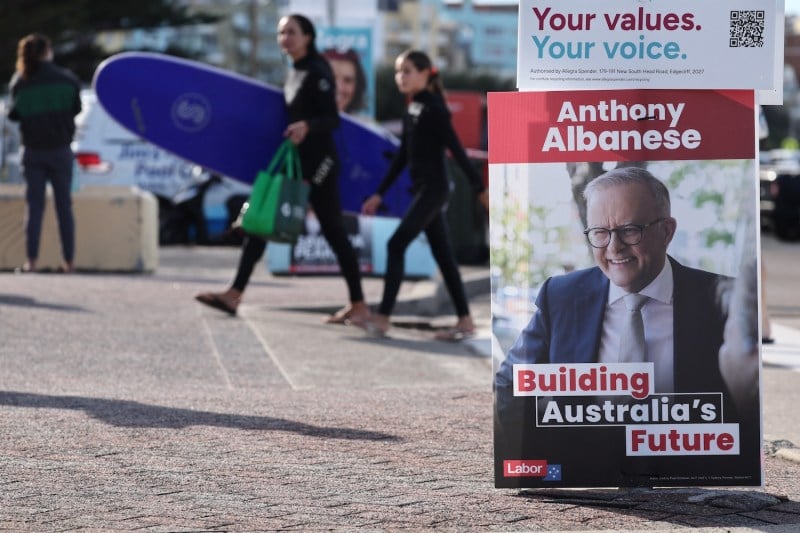A Massive Shared Military Deal May Be Europe’s Future

A Massive Shared Military Deal May Be Europe’s Future
Joint procurement is rare and hard—but also makes sense.
Swedish soldiers from a joint Finnish-Swedish division ride the CV90 as part of the NATO Nordic Response 24 military exercise, seen on the Norwegian side of the Kivilompolo border crossing between Finland and Norway on March 9, 2024.
Jonathan Nackstrand/AFP via Getty Images
Sweden, Norway, and Lithuania will team up to buy hundreds of soon-to-be-manufactured CV90 combat vehicles, Sweden’s prime minister announced late last month. Economies of scale matter in the military—but these kinds of deals are very difficult to execute, which is why they’re usually very rare. The three Nordic-Baltic nations may be about to set a new standard.
“The joint procurement will speed up the delivery, reduce the cost, and benefit our defense industrial links,” Prime Minister Ulf Kristersson of Sweden said on April 22. “With the CV90 [operating] in almost all Nordic and Baltic states, we can also improve our interoperability and our security of supply,” he added.
Sweden, Norway, and Lithuania will team up to buy hundreds of soon-to-be-manufactured CV90 combat vehicles, Sweden’s prime minister announced late last month. Economies of scale matter in the military—but these kinds of deals are very difficult to execute, which is why they’re usually very rare. The three Nordic-Baltic nations may be about to set a new standard.
“The joint procurement will speed up the delivery, reduce the cost, and benefit our defense industrial links,” Prime Minister Ulf Kristersson of Sweden said on April 22. “With the CV90 [operating] in almost all Nordic and Baltic states, we can also improve our interoperability and our security of supply,” he added.
The Swedish-made infantry fighting vehicle has long been popular among European armies: Denmark, Estonia, Finland, Norway, Sweden, Switzerland, the Netherlands, the Czech Republic, Slovakia, and Ukraine use it. It’s easy to see why: The CV90, which was developed for the Swedish military and hit the market in the 1990s, can perform many of the functions of a main battle tank (including taking on enemy tanks), but it’s smaller, more mobile, and more versatile.
Just last December, Denmark ordered 115 CV90s from BAE Systems Hagglunds (which manufactures them in Sweden), while the Swedish Armed Forces ordered 50. Two years ago, the Czech ordered nearly 250, and a few months before that, Slovakia bought more than 150.
And now there’s the planned Nordic-Baltic mass order. Finland initially expressed interest in the plan but later explained that it won’t participate in the joint procurement, instead presumably opting to make a separate one, but that still leaves three countries willing to attempt one of defense procurement’s most challenging moves. According to Lithuanian Prime Minister Gintautas Paluckas, it will involve some 1,000 CV90s.
Usually, the path of joint procurement is one of thorns, tears, delays, hurt feelings, and sometimes failure. In the 1980s, for example, several European nations decided to jointly order A400M transport planes, but agreeing on the details proved so difficult that the orders were not placed until the early 2000s; delivery of the planes began in the 2010s.
The countries participating in a joint NH90 helicopter order around the same time added so many individual specifications that “[i]n the end, there were 20 different versions. It was not a joint project anymore,” Hilmar Linnenkamp, a former deputy director of the European Defence Agency, told me for a piece about the curse of joint procurement that was published in Foreign Policy nine years ago.
Even in the friendly and collaborative Nordic-Baltic region, the process has produced a litany of failures in the past. The “Archer” artillery program “was initially a Swedish-Norwegian project, but the Norwegians left it in a pretty untidy fashion, which meant that Sweden had to buy those Archers, too,” recalled retired Rear Adm. Thomas Engevall, who worked until 2022 as the deputy national armaments director at the Swedish Defence Materiel Administration. “And Sweden also did a similar thing to Finland around 2007-2008, when cuts to the defense budget meant we had to abandon a joint torpedo, mine, and UW [underwater] sensor project with them,” he added. “It took the Finns several years to get over it.”
Project Viking, which was launched in the 1990s and involved Sweden, Norway, and Denmark jointly procuring submarines, had an even more ignominious end.
“At first it went well—then Denmark decided it didn’t need submarines after all, and then the Norwegians left, so the project came to naught,” Engevall told me.
It’s not the goodwill that has been lacking. “Countries have their own political and strategic priorities,” said Robert Limmergard, the director-general Sweden’s defense industry association, SOFF. “On top of that, there are invisible hurdles, including the fact that some governments prefer giving business to companies in their countries and may even own those companies.”
Then there’s the question of which country should do what, because all countries are keen that at least part of the manufacturing be handed to firms at home. “Governments usually feel they need to consider their domestic defense industry, so they’ll say, ‘if you do this, we do that,’” Engevall said. “That’s often inefficient and causes delays.”
Even more importantly, Limmergard pointed out, different countries’ ministries have different regulations, budget cycles, procedures, approvals processes, military requirements, and levels of ambition. Countries have squabbled over everything from vessel color to tanks’ leg space (an important detail if you’re Dutch, who are the tallest people in the world on average).
But these are no longer the comparatively peaceful times of a decade ago. Governments faced with the immediate threat of Russia no longer have the luxury of insisting on a transport plane, helicopter, or infantry fighting vehicle that is perfectly suited to their preferences. Things must go quickly, and given the threats on the horizon, governments also need maximum bang for their defense buck.
That makes governments more likely to buy more equipment off the shelf rather than commissioning a new version.
“Joint procurement of off-the-shelf equipment is much easier, and that’s what the new CV90 order is,” Engevall said. “The differences between what the countries need are very small, so joint procurement is simply a matter of buying many items of the same product.”
Kristersson had made much the same point. “Exactly how it will develop, it’s too early to tell, but I think there is a very good reason for this collaboration. We have too many platforms around Europe. We have too few countries collaborating in terms of procurement and standardization and things like that. So this is a good example that could be a showcase for other procurements as well,” he said during a visit to Lithuania.
And Lithuania is keen to point out that it, too, will benefit from the massive order. “Lithuania will receive about a hundred units, but we also expect Lithuanian businesses to participate in the production of the full batch,” Paluckas said after meeting with Kristersson.
Western armed forces will, of course, need to continue to work with the defense industry to develop tomorrow’s platforms and software—and everything in between. But now that things must proceed expeditiously, Sweden, Norway, and Lithuania are setting a benchmark with their straightforward CV90 order.
“These types of orders will increase dramatically,” Engevall said. “We just don’t have time to wait 10-15 years for a new product. And things are developing so quickly now that if you wait a decade for a new product, it may well be obsolete by the time you take possession of it.”
This trend has allowed new defense manufacturing players to emerge: Since Russia’s full-scale invasion began more than three years ago, Ukrainian firms have been pioneering defense innovation on the go.
The question is which countries will team up next—and nice guys finish first. The governments that have already shown they can work together with minimal friction are likely to be snapped up first. Even after this deal, Sweden, Norway, and Lithuania may also have a slot or two left on their dance cards.
Elisabeth Braw is a columnist at Foreign Policy, a senior fellow at the Atlantic Council, and the author of “Goodbye Globalization.” X: @elisabethbraw
More from Foreign Policy
-

A drawn illustration of a Trump whirlwind on a red background Four Explanatory Models for Trump’s Chaos
It’s clear that the second Trump administration is aiming for change—not inertia—in U.S. foreign policy.
-

Marco Rubio is seen up close, sitting on a couch beside J.D. Vance. Marco Rubio’s Soulless Crusade
The U.S. secretary of state stands for no principle other than serving the man who appointed him.
-

Soldiers from various NATO allies take part in a military exercise at the Smardan Training Area in Smardan, Romania, on Feb. 19. America Will Miss Europe’s Dependence When It’s Gone
European self-reliance for security will cost U.S. jobs, profits, and influence.
-

A collage photo illustration shows Donald Trump gesturing with arms wide. In front of him are headshots of Benjamin Netanyahu and Vlodymyr Zelensky, images of immigratns and ICE police, a tattered EU flag and America First signs. Trump’s First 100 Days on the Global Stage
Ten thinkers on what to make of the opening salvo of the president’s second term.











Join the Conversation
Commenting on this and other recent articles is just one benefit of a Foreign Policy subscription.
Already a subscriber?
.
Subscribe
Subscribe
View Comments
Join the Conversation
Join the conversation on this and other recent Foreign Policy articles when you subscribe now.
Subscribe
Subscribe
Not your account?
View Comments
Join the Conversation
Please follow our comment guidelines, stay on topic, and be civil, courteous, and respectful of others’ beliefs.
Change your username |
Log out
Change your username:
CANCEL
Confirm your username to get started.
The default username below has been generated using the first name and last initial on your FP subscriber account. Usernames may be updated at any time and must not contain inappropriate or offensive language.